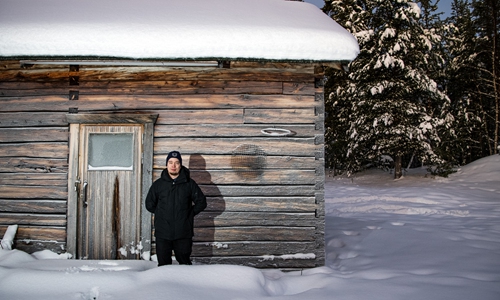HOME >> ARTS
Rap helps revive Lapland's endangered languages
Source:AFP Published: 2020/4/9 15:28:41

Rapper Ailu Valle poses in front of his home on December 6, 2019 in Inari, Finland. Photo: AFP
Sporting a gray hoodie, goatee beard and oversize headphones, rapper Amoc spits a stream of aggressive, staccato rhymes into the microphone of his home studio as he works on new material.
The punchy rhythm of the 35-year-old's vocals would sound familiar to rap lovers all over the world.
But Amoc's lyrics are only understandable to the 300 speakers of the seriously endangered language of Inari Sami, from Finland's far north.
Until the middle of the last century, the 10 languages of the indigenous Sami people - who are spread across the northern parts of Norway, Sweden, Finland and Russia - were decimated by brutal assimilation policies by their governments.
Now, a new generation of young speakers has spawned music, TV programs and even a Disney blockbuster, in a "golden age" for Sami languages.
But re-learning the almost-forgotten tongues has stirred up painful memories of past injustices against the Sami.
"The more you learn," says Sami parliament president Tiina Sanila-Aikio, "the more you realize this might be something that you cannot ever take back as a mother tongue."
Not flowers but violence
When Amoc - real name Mikkal Morottaja - started rapping two decades ago, only "10 or fewer" young people could speak his language.
His preferred themes of "occultist horror and violence" did not always go down well with the other Inari Sami speakers, who thought his lyrics would be more traditional.
"The older people didn't realize that it's not about flowers and nature," he tells AFP.
"I don't think they liked my music so much."
Morottaja often has to innovate to express modern concepts in a language more tailored to describing indigenous traditions such as reindeer herding.
Inari Sami used to have no word for outer space, for instance.
But his father, Matti, an activist and president of the language council, has been able to advise and even help create new constructions.
In the case of "space," Inari Sami has now adopted komovuota, which literally means "openness."
Morottaja's latest project is a collaboration with fellow Sami rapper Ailu Valle.
Valle speaks a different language, Northern Sami, with 25,000 speakers and classed as "endangered" by UNESCO.
The pair have played gigs far beyond Sami-speaking areas: in the US, Canada and around Europe.
Initially inspired by Eminem and the Wu-Tang Clan, Valle first rapped in English and Finnish, avoiding Northern Sami.
"I thought I'd need urban vocabulary," he tells AFP in his remote wooden home on the shore of the frozen Ivalo river.
But learning at university about his culture and its history of oppression sparked a determination to sing in Sami.
"I thought it's the same as in America," Valle says.
"A minority expressing themselves in their own community and within the bigger society."
His early songs drew on Sami literature, including the internationally acclaimed poet Nils-Aslak Valkeapaa, whose 1988 epic Beaivi ahcazan (The Sun, My Father) is an intimate and melodic voyage through thousands of years of Sami history.
Immersive 'language nests'
Until at least the 1960s, Sami children were routinely forbidden to use their mother tongue at school, under an education system that saw Sami people as second-class citizens to be assimilated into mainstream society.
But a gradual shift in attitudes across the Nordic countries resulted in a milestone in 1992, when Finland passed a Sami language law giving speakers the right to use their mother tongue with authorities.
Since then, the number of younger speakers has grown thanks to immersive "language nest" schools and nurseries, a policy copied from New Zealand's Maori language revival.
Yet still only a quarter of the country's 10,000 Sami speak a Sami language, Finland's Sami parliament says.
"One major concern is that rights to education and services in Sami only apply in Lapland's designated Sami region," parliament's language protection secretary Anne Kirste Aikio tells AFP.
"Even though over half of Sami live in cities and elsewhere."
Finland's center-left government has promised to address the issue, such as by expanding distance and online teaching in Sami.
For now, the children's program Unna Junna is a vital resource.
Produced since 2007 by Finnish broadcaster YLE, each episode covers aspects of Sami life, in all three of Finland's Sami languages.
Producer Heli Huovinen and her small team sometimes ask viewers and their parents what they would like to see.
"They want more films about nature, about animals, about traditional Sami things and ways of life," she tells AFP.
"We were expecting modern things like robots and computer games."
Huovinen, in her early 30s, grew up with a strong Inari Sami identity but had no opportunities to learn the language until she was 16 in high school.
"It would have been so cool to have Sami children's TV, I could have learned from that," she says.
"So I'm very happy that we have children's TV now."
But Sami's growing popularity has also highlighted a shortage of resources and teachers.
"We need more schoolbooks, we need more media, we need more arts and all kinds of support," Huovinen says.
Newspaper headline: Saving Sami
Posted in: ART,CULTURE & LEISURE